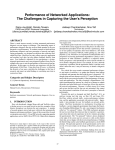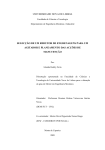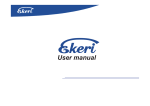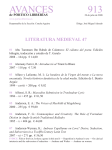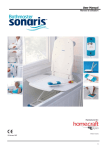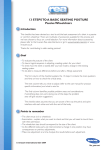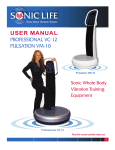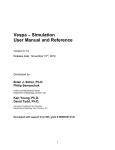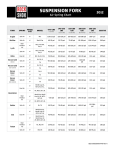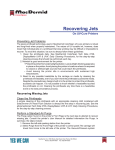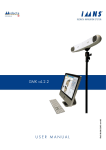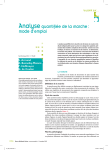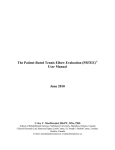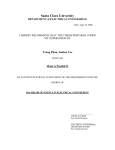Download Tennis Elbow MDS
Transcript
PATIENT-RATED TENNIS ELBOW EVALUATION Name _______________________________ Date______________ The questions below will help us understand the amount of difficulty you have had with your arm in the past week. You will be describing your average arm symptoms over the past week on a scale 0-10. Please provide an answer for all questions. If you did not perform an activity because of pain or because you were unable, then you should circle a “10”. If you are unsure please estimate to the best of your ability. Only leave items blank if you never perform that activity. Please indicate this by drawing a line completely through the question. 1. PAIN in your affected arm Rate the average amount of pain in your arm over the past week by circling the number that best describes your pain on a scale from 0-10. A zero (0) means that you did not have any pain and a ten (10) means that you had the worst pain imaginable. RATE YOUR PAIN: Worst No Pain Imaginable When your are at rest 0 1 2 3 4 5 6 7 8 9 10 When doing a task with repeated arm 0 1 2 3 4 5 6 7 8 9 10 When carrying a plastic bag of groceries 0 1 2 3 4 5 6 7 8 9 10 When your pain was at its least 0 1 2 3 4 5 6 7 8 9 10 When your pain was at its worst 0 1 2 3 4 5 6 7 8 9 10 movement Please turn the page...... 2. FUNCTIONAL DISABILITY A. SPECIFIC ACTIVITIES Rate the amount of difficulty you experienced performing each of the tasks listed below, over the past week, by circling the number that best describes your difficulty on a scale of 0-10. A zero (0) means you did not experience any difficulty and a ten (10) means it was so difficult you were unable to do it at all. No Unable Difficulty To Do Turn a doorknob or key 0 1 2 3 4 5 6 7 8 9 10 Carry a grocery bag or briefcase by the handle 0 1 2 3 4 5 6 7 8 9 10 Lift a full coffee cup or glass of milk to your 0 1 2 3 4 5 6 7 8 9 10 mouth Open a jar 0 1 2 3 4 5 6 7 8 9 10 Pull up pants 0 1 2 3 4 5 6 7 8 9 10 Wring out a washcloth or wet towel 0 1 2 3 4 5 6 7 8 9 10 B. USUAL ACTIVITIES Rate the amount of difficulty you experienced performing your usual activities in each of the areas listed below, over the past week, by circling the number that best describes your difficulty on a scale of 0-10. By “usual activities”, we mean the activities that you performed before you started having a problem with your arm. A zero (0) means you did not experience any difficulty and a ten (10) means it was so difficulty you were unable to do any of your usual activities. 1. Personal activities (dressing, washing) 0 1 2 3 4 5 6 7 8 9 10 2. Household work (cleaning, maintenance) 0 1 2 3 4 5 6 7 8 9 10 3. Work (your job or everyday work) 0 1 2 3 4 5 6 7 8 9 10 4. Recreational or sporting activities 0 1 2 3 4 5 6 7 8 9 10 Comments: © MacDermid 2005 PRTEE Scoring Instructions Minimize non-response by checking forms when patients complete them. Make sure that the patient left an item blank because they could not do it, that they understand that should have recorded this item as a “10”. If patients are unsure because they have rarely performed an activity in the past week, then they should be encouraged to estimate their average difficulty. This will be more accurate than leaving it blank. If they never perform an activity they will not be able to estimate and should leave it blank. If items from a subscale are left blank, then you can substitute the average score from that subscale. Pain Subscale- Add up 5 items. Best score= 0; Worst score =50 Specific Activities- Add up 6 items Best Score= 0; Worst Score = 60 Usual Activities – Add up 4 items items Best Score= 0; Worst Score = 40 Function Subscale- (Specific Activities + Usual Activities)/2- Best score= 0; Worst score =50 Total Score = Pain Subscale + Function Subscale Best Score= 0 Worst Score = 100 (pain and disability contribute equally to score) Reliability of subscales and total score are sufficiently high that both subscales and total are reportable. © MacDermid 2005 Minimal Data Set for Non-surgical Lateral Epicondylitis in Adults Demographic Information Sex: Male Female Age:_______y.o. Occupation:_____________________________ Do you perform any repetitive or forceful tasks or movements? Yes: No: If yes: What type? _____________________________________________________ Do you have any known cervical or thoracic pain and/or dysfunction? Yes: No: If yes: Explain: ________________________________________________________ Do you smoke or previously smoked? Yes: No: Diagnostic Tools Cozens: Positive Negative Mills: Positive Negative Maudsley: Positive Negative Grip Strength: Right____________lbs. Left_____________lbs. PRTEE Questionaire: Pain Subscale________________ Specific Activities_________________ Usual Activities______________ Functional Activities_______________ Total_______________________ Information & Instructions for MDS for Non-surgical Lateral Epicondylitis in Adults Clinical Question: Is physical therapy with the use of a tennis elbow brace more beneficial in decreasing pain than standard physical therapy for patients with lateral epicondylitis? Demographic data includes risk factors associated with lateral epicondylitis including female, smoking or a previous history of smoking, age>40, and performing repetitive tasks or movements. Diagnostic Tools: Cozens Test is performed with the patients hand in a full fist and pronation while resisting extension and radial deviation; palpate over the lateral epicondyle. A positive test is pain reproduction over the lateral epicondyle. The Mills Test is performed with the patient relaxed. Passively move the patient from elbow flexion into wrist flexion and elbow extension. A positive test is reproduction of pain. The Maudsley Test is performed by resisting third finger extension. A positive test is reproduction of pain. The Grip Strength test uses a hand held dynamometer to objectively test the strength of muscles involved in gripping. The Jamar dynamometer is the gold standard for testing hand grip strength and the correlation coefficients for this particular device is 0 .954. To perform the test, the manufacture recommends these parameters for testing: Have the individual sit with their shoulder adducted and neutrally rotated, elbow flexed at 90º, forearm in neutral position, and wrist between 0º and 30º dorsiflexion and between 0º and 15º ulnar deviation. Set the Jamar hand dynamometer to the second handle position from the inside. Lightly hold around the readout dial to prevent inadvertent dropping. After the individual is positioned properly, say, “Squeeze as hard as you can...harder!...harder!...relax.” Record the scores of three successive trials for each hand tested. The average score of the three trials can be compared to the normative data on the left, which is in pounds. From a statistical perspective, scores within two standard deviations of the mean are considered within normal limits. In addition, the individuals’ ability to use their hand functionally needs to be considered when interpreting a grip strength performance. For normative data see page 7. The PRTEE Questionnaire, previously known as the patient rated forearm evaluation questionnaire, is used to assess forearm pain and disability from lateral epicondylitis. This can be used to indicate a baseline and a measure of progress. Instructions in administering and grading the questionnaire can be found on pages 1-4. The tests re-test reliability for both parts of this questionnaire were excellent. A good correlation was found with the visual analog scale (VAS) and the disability of arm, shoulder, and hand questionnaire (DASH). Created by: Traci Delgado, Emilia Kubera, MeL. Vicencio Date: June 8, 2011 Males Females Age Hand Mean SD Mean SD 6-7 R 32.5 4.8 28.6 4.4 L 30.7 5.4 27.1 4.4 8-9 L R 64.8 41.9 18.1 7.4 41.5 35.3 10.2 8.3 75+ R L 65.7 39.0 21.0 9.3 42.6 33.0 11.0 6.9 10-11 L R 55.0 53.9 17.0 9.7 37.6 49.7 8.9 8.1 L 48.4 10.8 45.2 6.8 R 58.7 15.5 56.8 10.6 L 55.4 16.9 50.9 11.9 R 77.3 15.4 58.1 12.3 L 64.4 14.9 49.3 11.9 R 94.0 19.4 67.3 16.5 L 78.5 19.1 56.9 14.0 R 108.0 24.6 71.6 12.3 L 93.0 27.8 61.7 12.5 R 121.0 20.6 70.4 14.5 L 104.5 21.8 61.0 13.1 R 120.8 23.0 74.5 13.9 L 110.5 16.2 63.5 12.2 R 121.8 22.4 78.7 19.2 L 110.4 21.7 68.0 17.7 R 119.7 24.0 74.1 10.8 L 112.9 21.7 66.3 11.7 R 116.8 20.7 70.4 13.5 L 112.8 18.7 62.3 13.8 R 109.9 23.0 62.2 15.1 L 100.8 22.8 56.0 12.7 R 113.6 18.1 65.8 11.6 L 101.9 17.0 57.3 10.7 R 101.1 26.7 57.3 12.5 L 83.2 23.4 47.3 11.9 R 89.7 20.4 55.1 10.1 L 76.8 20.3 45.7 10.1 R 91.1 20.6 49.6 9.7 L 76.8 19.8 41.0 8.2 R 75.3 21.5 49.6 11.7 12-13 14-15 16-17 18-19 20-24 25-29 30-34 35-39 40-44 45-49 50-54 55-59 60-64 65-69 70-74 References 1. Alizadehkhaiyat O, Fisher AC, Kemp GJ, Vishwanathan K, Frostick SP. Assessment of functional recovery in tennis elbow. J Electromyogr Kinesiol. 2009;19:631-638. 2. Berglund KM, Persson BH, Denison E. Prevalence of pain and dysfunction in the cervical and thoracic spine in persons with and without lateral elbow pain. Man Ther. 2008;13:295-299. 3. Fan ZJ, Silverstein BA, Bao S, et al. Quantitative exposure-response relations between physical workload and prevalence of lateral epicondylitis in a working population. Am J Ind Med. 2009;52:479-490. 4. JAMAR: Hydraulic Hand Dynamometer Owner’s Manual. Bolingbrook, IL: Sammons Preston Rolyan; 2003:3-5 5. MacDermid JC. The Patient-Rated Tennis Elbow Evaluation (PRTEE) User Manual. Ontario, Canada; 2007 6. Magee, J. Orthopedic Physical Assessment. 5th ed. St. Louis, MO: Saunders Elsevier Inc; 2008:379-380. 7. Milias GA, Antonopoulou S, Athanasopoulos S. Development, reliability and validity of a new motorized isometric dynamometer for measuring strength characteristics of elbow flexor muscles. Journal of Medical Engineering & Technology. 2008;23:66-72. 8. Newcomer KL, Martinez-Silvestrini JA, Schaefer MP, Gay RE, Arendt KW. Sensitivity of the Patient-rated Forearm Evaluation Questionnaire in lateral epicondylitis. J Hand Ther. 2005;18:400-406. 9. Rompe JD, Overend TJ, MacDermid JC. Validation of the Patient-rated Tennis Elbow Evaluation Questionnaire. J Hand Ther. 2007;20:3-10. 10. Roquelaure Y, Ha C, Leclerc A, et al. Epidemiologic surveillance of upper-extremity musculoskeletal disorders in the working population. Arthritis Rheum. 2006;55:765-778. 11. Shiri R, Viikari-Juntura E, Varonen H, Heliovaara M. Prevalence and determinants of lateral and medial epicondylitis: a population study. Am J Epidemiol. 2006;164:1065-1074. 12. Waersted M, Hanvold TN, Veiersted KB. Computer work and musculoskeletal disorders of the neck and upper extremity: a systematic review. BMC Musculoskelet Disord. 2010;11:79. 13. Wolf JM, Mountcastle S, Burks R, Sturdivant RX, Owens BD. Epidemiology of lateral and medial epicondylitis in a military population. Mil Med. 2010;175:336-339.








